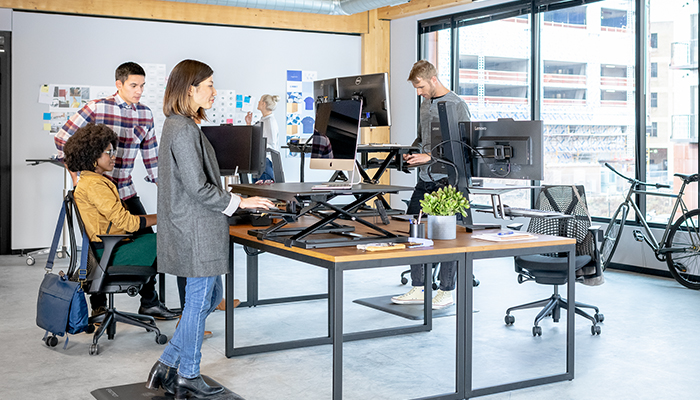Finding effective ways to collaborate at work involves more than just software.
We connected with members of our Customer Marketing and Innovation Team to learn about the importance of face-to-face workplace collaboration and how to spark it in any organization. Here’s a summary of the team’s insights.
Q1: Why should organizations focus on collaboration?
Effective collaboration is the hallmark of high-functioning teams. It’s not surprising that a survey of workers in the U.S., United Kingdom, France and Germany found that the most satisfied employees scored “opportunities to work on a collaborative team” as the best way to boost their careers. This fact is not lost on the software industry. In fact, the global market for collaboration software is expected to hit $9 billion in 2019.
Q2: Are you saying software is key to effective collaboration?
Only partly. There are countless applications enabling collaboration, such as G-Suite apps that let team members across the world work on the same document in real time. Many of those apps are great, but face-to-face interaction is vitally important too.
Q3: Why?
Humans are social creatures and there is no better way to build relationships between colleagues than with face-to-face communication. Ideas get sparked when people talk to each other. Companies such as Apple and Google know this, which is why they’ve invested in workspaces that actively encourage movement, communication and cooperation. Productivity and job satisfaction also increase when people talk in person.
Q4: Why can’t collaboration software enable the same benefits?
The advantages of face-to-face interaction go beyond the rational. Doctors at the Stanford University School of Medicine have found that humans produce oxytocin—the “love hormone”—when we interact in person. That releases serotonin, which results in a palpable sense of happiness. It just makes sense that people who talk face-to-face with colleagues feel more valued, satisfied with their jobs, and more closely aligned with the goals of their organizations.
Q5: Any workplace research to back that up?
According to this Forbes article, there are several studies that found “it is more difficult to build trust in virtual teams, harder for informal leaders to emerge, tougher to create genuine dialogue, and easier for misunderstandings to escalate.”
 Q6: How can organizations foster more direct collaboration?
Q6: How can organizations foster more direct collaboration?
Start by thinking about how performance is evaluated and rewarded. Individual, accountability-based tasks often are isolating and can lead people to become protective of their ideas. By contrast, collaboration leads to varied perspectives, new opinions and ideas, and, therefore, more objective results. So maybe it’s time to focus on team-based performance indicators in certain areas. I believe this will have a positive impact on productivity and profitability.
Q7: Are there physical changes that can improve workplace collaboration?
Absolutely. Presentations, task-based work, idea generation, planning and problem-solving all involve information that must be visible to everyone. Now picture five or more people hunched over a laptop or craning their necks to see a fixed screen. That’s just not effective. But simply adding a monitor arm so that screen can be positioned for everyone to see it can make a big difference.
Q8: Are you advocating for the death of the whiteboard?
Whiteboards have limitations. Brainstorming in a small group often means gathering in a room with a whiteboard, with each person hugging their laptop. If the room was equipped with a couple of monitors on monitor arms, people could connect their laptops and share their screens with the group in a much more visible way.
Q9: Are you saying monitor arms turn workspace into collaboration space?
Exactly. A fully adjustable monitor arm enables people to work faster and more easily together. The ability to move screens freely to accommodate ideas should not be underestimated. Multi-screen options are another good investment. Along with a choice of flexible, articulated arms and desk mounts, they make workplace collaboration much easier and more comfortable, as well as healthier, with workers being able to stand up and move while working.
Q10: Any advice for C-Suite key decision makers?
Adopting this face-to-face collaboration mindset and translating it into a working reality makes a highly effective statement about the culture you wish to promote and the value you place on a happy, effective and engaged workforce. Leaders should consider collaboration as one important way to tackle engagement, which directly impacts organizational goals and, ultimately, the bottom line.



